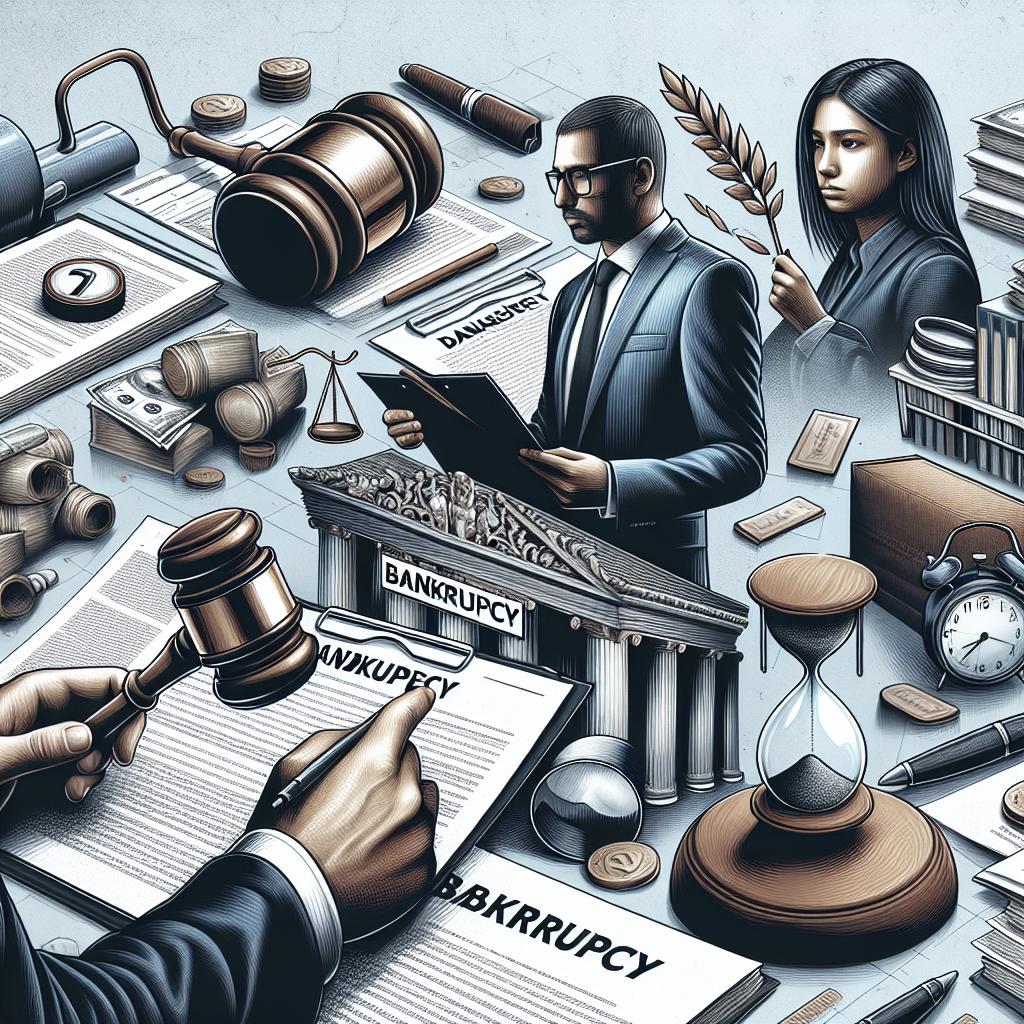“`html
How to Handle Bankruptcy Cases
Dealing with bankruptcy can be overwhelming, whether you’re an individual, business owner, or employee affected by a company’s insolvency. This blog post provides a comprehensive guide on handling bankruptcy cases, offering valuable insights into the process, the roles of Licensed Insolvency Trustees, the rights and obligations of creditors, and the methods to recover funds. Each section will provide practical advice on specific scenarios, such as an employer’s bankruptcy, claims submissions, creditor meetings, asset retrieval, and advance payment issues. By understanding these facets, you can make informed decisions during this challenging time.
About Bankruptcy
Bankruptcy is a legal process initiated when an individual or business cannot meet their debt obligations. It provides a fresh start for debtors while ensuring fair treatment for creditors. The process involves liquidating assets to repay as much debt as possible. Bankruptcy cases are handled under federal laws, which lay out specific rules and regulations to manage debts and protect both debtors and creditors.
A person or business facing insurmountable debt may voluntarily file for bankruptcy, or in certain cases, creditors can petition the court to declare a debtor bankrupt. There are different types of bankruptcies, including Chapter 7, which involves liquidation, and Chapter 13, which involves restructuring debts and creating a repayment plan. The specific type of bankruptcy filed will determine the pathway towards resolving debt issues.
About Licensed Insolvency Trustees
Licensed Insolvency Trustees (LITs) are professionals authorized to administer bankruptcy cases. Their role is to guide debtors through the bankruptcy process, manage the assets, and ensure that all legal requirements are met. Trustees act as intermediaries between debtors and creditors, ensuring fair and equitable treatment of all parties involved.
LITs are responsible for evaluating the debtor’s financial situation, organizing meetings with creditors, and preparing mandatory documentation. Their expertise can considerably ease the navigation through complex legal protocols, offering strategic advice to minimize the impact on the debtor’s financial future. Choosing the right trustee is essential, as their skills and experience can significantly influence the bankruptcy outcome.
Your Employer is Bankrupt
If your employer declares bankruptcy, it’s essential to understand your rights as an employee. Firstly, determine the status of your employment. Often, business operations may temporarily continue, even under bankruptcy protection. However, there could be layoffs or closures, affecting both wages and benefits.
In the event of termination, employees may be eligible to file a claim for any unpaid wages, severance, or vacation pay. It’s critical to adhere to deadlines and submit all necessary documentation to increase the likelihood of receiving any debts owed by the employer. Employee claims often have a higher priority, but this can vary based on specific legal provisions.
Proof of Claim Form
The Proof of Claim form is a vital document for creditors seeking to recover debts from a bankrupt entity. To participate in bankruptcy proceedings and receive any payable dividends, creditors must submit this form, providing details of the owed amounts and supporting evidence.
Completing the Proof of Claim accurately and promptly is crucial, as it establishes a creditor’s claim in the bankruptcy case. Missing the submission deadline can forfeit a creditor’s rights to payment, underscoring the importance of adhering to procedural guidelines. Legal counsel or guidance from a Licensed Insolvency Trustee can aid in completing this process correctly.
Important
Accuracy in the Proof of Claim is paramount. Mistakes in either calculation or documentation can lead to disputes or dismissal of the claim. Providing clear, detailed evidence supporting the claimed amount strengthens the validity of the submission.
Stakeholders should be vigilant about deadlines for submission and any amendments, as timeliness can affect the ability to partake in the creditor meeting and dividend distribution. Being well-informed and proactive can significantly impact recovery outcomes in a bankruptcy proceeding.
Meeting of Creditors
During a bankruptcy process, a meeting of creditors is organized, allowing stakeholders to discuss the bankrupt entity’s financial status and the assets available for liquidation. This meeting, conducted by the Licensed Insolvency Trustee, provides transparency and fosters communication among involved parties.
Creditors are invited to ask questions, raise concerns, and vote on pivotal decisions regarding the management of the bankruptcy case. Attending this meeting offers an opportunity to influence the outcome, ensure the accountability of the trustee, and collectively deliberate on maximizing debt recovery efforts.
Preferences or Transfers at Undervalue
In some cases, debtors may have engaged in preferential transactions or transferred assets at undervalued rates before declaring bankruptcy. Such transactions, if deemed as attempts to defraud creditors, can be voided by the court, retrieving the assets in question for equitable distribution.
Identifying and challenging preferential transactions requires thorough investigation and expertise. Creditors should collaborate with the Licensed Insolvency Trustee to evaluate suspect dealings and potentially recover additional funds. These efforts protect the equitable distribution of assets to all creditors involved.
How Funds Are Recovered and Distributed
Fund recovery in bankruptcy involves liquidating the debtor’s assets, with proceeds distributed among creditors according to priority legal standings. Secured creditors are typically paid first, followed by unsecured creditors based on the order of claims filed and adjudicated.
The Licensed Insolvency Trustee oversees the asset distribution process to ensure transparency and legal compliance. Creditors can expect periodic updates on fund recovery efforts and distribution schedules, enabling them to track potential recovery outcomes and assess case progress effectively.
Closing the Bankruptcy
The bankruptcy process concludes when the court formally discharges the debtor’s remaining debts, signifying the end of financial obligations for eligible claims. This discharge occurs after the debtor complies with all bankruptcy obligations and applicable court mandates.
Once discharged, debtors can commence rebuilding their financial status, while creditors receive final notifications regarding dividend distributions and closure circumstances. Understanding the closure process and associating timelines helps participants manage expectations effectively.
Unclaimed Dividends
Occasionally, during the distribution process, some dividends go unclaimed, either due to unlocated creditors or documentation lapses. Trustees typically hold these funds for a predetermined period, as guided by legal regulations, before channeling them to a designated government fund.
Creditors should remain proactive in updating contact information and monitoring the bankruptcy proceedings to facilitate the claiming of any outstanding dividends. Engaging with the trustee helps ensure informed participation and potential recovery of any uncollected funds.
Complaints
Engaged parties in a bankruptcy case can sometimes find themselves dissatisfied with the proceedings or decisions undertaken by the Licensed Insolvency Trustee. In such instances, formal complaint procedures are available for addressing grievances effectively.
Stakeholders should submit complaints to the appropriate regulatory bodies, detailing the specific issues experienced. These complaints are evaluated impartially to ascertain whether the trustee adhered to statutory responsibilities and fair practice standards, ensuring accountability within the case management.
Mediation
When disputes arise during the bankruptcy process, mediation offers an alternative to traditional litigation, aiming for amicable resolutions. Mediation involves negotiation facilitated by an impartial mediator, focusing on collaborative problem-solving.
This approach can effectively resolve conflicts among stakeholders regarding asset distribution, creditor claims, or trustee decisions, while minimizing costs and preserving relationships. Mediation is particularly beneficial when parties are inclined toward reaching mutually agreeable outcomes without resorting to prolonged legal battles.
How Do I Find Out If a Person or a Business Has Declared Bankruptcy?
To check if an individual or a business has filed for bankruptcy, a comprehensive search within bankruptcy registries maintained by federal authorities can provide the necessary information. These records offer details on bankruptcy filings, trustee appointments, and pertinent legal proceedings.
Many jurisdictions offer online access to bankruptcy databases, streamlining the search process. By utilizing these resources, interested parties can remain informed about potential bankruptcy declarations and adjust their business dealings or financial strategies accordingly.
I Own Assets That Are Located on the Premises of a Company That Has Declared Bankruptcy and Have Been Unable to Retrieve Them. What Should I Do?
When assets belonging to you are held within the premises of a bankrupt company, it’s crucial to act swiftly to assert ownership claims. Communicate directly with the Licensed Insolvency Trustee overseeing the case, presenting proof of ownership for the assets in question.
In cases where retrieval is complicated due to existing liens or contractual agreements, seeking legal counsel can help navigate the recovery process effectively. Prompt action minimizes the risk of your assets being included in the company’s asset pool inadvertently.
I Made an Advance Payment to a Company That Has Declared Bankruptcy. What Can I Do?
Advance payments made to businesses declaring bankruptcy present challenges in recovering funds. The first step is to file a claim with the trustee, providing proof of payment and any contractual agreements outlining the transaction details.
Negotiating with the trustee and monitoring the bankruptcy proceedings closely can increase the likelihood of recuperating the advance. In certain scenarios, initiating mediation or legal proceedings may provide additional avenues for resolution and recovery.
Lessons Learned
| Aspect | Key Points |
|---|---|
| About Bankruptcy | Legal process to manage debts; involves liquidation or restructuring with designated chapters. |
| Licensed Insolvency Trustees | Authorized professionals guiding bankruptcy cases, intermediary role for debtors/creditors. |
| Your Employer is Bankrupt | Employee rights need assessing; claims for unpaid wages and benefits possible. |
| Proof of Claim Form | Crucial for creditors to file timely for debt recovery, requiring the detailed documentation. |
| Meeting of Creditors | Platform for stakeholders to discuss case dynamics and influence decisions. |
| Preferences or Transfers at Undervalue | Potential asset recovery through challenging suspect transactions. |
| Funds Recovery and Distribution | Liquidation proceeds follow a legal prioritization, overseen by trustees. |
| Closing the Bankruptcy | Concludes with discharge; involves compliance and formal notifications. |
| Unclaimed Dividends | Require stakeholder vigilance; could lead to forfeiture if not claimed. |
| Complaints | Formal channels exist for addressing dissatisfaction with proceedings or trustee actions. |
| Mediation | Serves as an alternate, cost-effective dispute resolution method during bankruptcy proceedings. |
| Bankruptcy Declarations | Bankruptcy registries available for verifying filed cases, accessible online in many areas. |
| Asset Retrieval from Bankrupt Companies | Assert ownership promptly through trustees, legal aid if necessary for complex claims. |
| Advance Payments to Bankrupt Companies | File claims with detailed proof, explore mediation or legal action for resolution. |
“`


